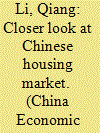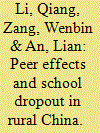|
|
|
Sort Order |
|
|
|
Items / Page
|
|
|
|
|
|
|
| Srl | Item |
| 1 |
ID:
187873


|
|
|
|
|
| Summary/Abstract |
In this paper, we study intra-city connections of housing submarkets, using data from two systemically important cities in China, Shanghai and Guangzhou. Chinese cities that underwent significant spatial and population growth in recent years provide an ideal testing ground for theories of urban spatial growth and the filtering models of housing market. By employing variance decompositions from vector autoregression models, we characterize three types of market connectedness. We find that price shocks mostly originate from the central areas and transmit to the suburban areas in both cities. Additionally, shocks usually run from new sale to resale markets, supporting the basic premise of filtering models. In both cities, trading volume shocks generally lead price shocks both within and across areas.
|
|
|
|
|
|
|
|
|
|
|
|
|
|
|
|
| 2 |
ID:
096736


|
|
|
|
|
| Publication |
2010.
|
| Summary/Abstract |
Significant pressure from increasing CO2 emissions and energy consumption in China's industrialization process has highlighted a need to understand and mitigate the sources of these emissions. Ammonia production, as one of the most important fundamental industries in China, represents those heavy industries that contribute largely to this sharp increasing trend. In the country with the largest population in the world, ammonia output has undergone fast growth spurred by increasing demand for fertilizer of food production since 1950s. However, various types of technologies implemented in the industry make ammonia plants in China operate with huge differences in both energy consumption and CO2 emissions. With consideration of these unique features, this paper attempts to estimate the amount of CO2 emission from China's ammonia production, and analyze the potential for carbon mitigation in the industry. Based on the estimation, related policy implications and measures required to realize the potential for mitigation are also discussed.
|
|
|
|
|
|
|
|
|
|
|
|
|
|
|
|
| 3 |
ID:
143381


|
|
|
|
|
| Summary/Abstract |
Child health is not only a key indicator of overall quality of public health, but also vital for the future economic development of a country. In recent years, with unprecedented urbanization of China, many children in rural areas have been left behind while their parents migrate to urban areas to seek employment opportunities. Thus, it is considerably important for us to understand the effects of lack of parental care on the health status of left-behind children. Using data from China Health and Nutrition Survey (CHNS), we find that the left-behind children in rural areas are significantly 20.0% more likely to get sick or develop chronic conditions than those living with their parents. We also find that girls are more vulnerable than boys and younger children are more vulnerable than older children to lack of parental care.
|
|
|
|
|
|
|
|
|
|
|
|
|
|
|
|
| 4 |
ID:
124559


|
|
|
|
|
| Publication |
2013.
|
| Summary/Abstract |
This paper attempts to identify neighborhood peer effects on children's dropout decision in rural China using the China Health and Nutrition Survey data (CHNS). Identifying peer effect is complicated by several endogenity problems including "self-selection" problem, "reflective" problem and uncontrolled "correlated effect". By taking advantage of the special feature of "Hukou" system and "son preference" phenomenon in rural China, the endogenity issues are quite reasonably addressed. More specifically, we discover a new and valid instrumental variable for peer's dropout rate: peers' firstborn boy rate. Intuitively, the more the firstborn boy peers, the lower the peers' dropout rate because of son preference and the lower one's own dropout probability due to peer effect. It is found that as peers' dropout rates increase by one percentage point, the child dropout rate would increase by 0.393 to 0.504 percentage points, the corresponding social multiplier effects of peer dropout are from 1.647 to 2.016. It is also found that elder kids and females are more susceptible to peer pressure in dropout decisions. Many other interesting findings are documented.
|
|
|
|
|
|
|
|
|
|
|
|
|
|
|
|
|
|
|
|
|